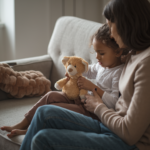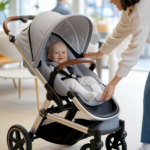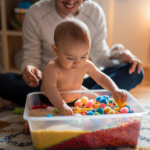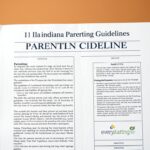Creating a DIY sensory bin for your baby is one of the easiest and most fun ways to help them explore the world through touch, sight, and sound. Sensory bins provide an excellent opportunity for babies to engage their senses and enhance their cognitive and motor skills. In this article, we’ll walk you through how to create a sensory bin at home using everyday materials, and explain why this activity is crucial for your baby’s development.
Why DIY Sensory Bins are Important for Babies
Babies learn best when they are allowed to explore their surroundings freely. A sensory bin is a container filled with materials that engage a baby’s senses, including touch, sight, and sometimes sound. These bins encourage fine motor skills as babies pick up, move, and manipulate objects. It also boosts cognitive development as babies learn about different textures, colors, and even cause and effect.
Creating a sensory bin at home is not only cost-effective but also an excellent way to keep your baby entertained and engaged. With a few materials that you probably already have at home, you can provide hours of developmental fun.
Materials You’ll Need for a DIY Sensory Bin
Before getting started, here’s a list of materials you can use to create your DIY sensory bin. These items can be mixed and matched depending on what you have available and what your baby enjoys.
- A shallow bin: A large, shallow plastic bin works best.
- Fillers: These are the main components of your bin and could include rice, pasta, pom-poms, fabric scraps, or water beads.
- Tools: Small scoops, cups, or tongs that allow babies to manipulate the objects.
- Themed objects: Items related to a specific theme (e.g., seashells for a beach theme, leaves for an autumn theme).
- Optional add-ons: Safe-smelling items like cinnamon sticks or lavender for scent-based play.
Make sure all items are safe for your baby to touch and explore, and never leave them unsupervised with the sensory bin, especially if it includes small objects.
Step-by-Step Guide to Creating a Sensory Bin
Step 1: Choose a Theme
Choosing a theme helps guide what materials to use. Some fun and easy themes include:
- Beach Day: Fill your bin with sand, seashells, and small toys like fish or boats.
- Autumn Leaves: Use dry leaves, acorns, and small branches for a fall-themed bin.
- Winter Wonderland: Fill the bin with cotton balls, white pom-poms, and glittery items to resemble snow.
By selecting a theme, you can introduce your baby to different seasons, holidays, or everyday life concepts, all while they engage their senses.
Step 2: Select Your Fillers
Once you’ve chosen a theme, select the filler materials for your sensory bin. Here are some filler ideas:
- Rice or pasta: These are great for tactile exploration and easy to clean up.
- Water beads: These are squishy and provide a completely different tactile sensation.
- Pom-poms: These soft, colorful balls are fun to touch and manipulate.
- Sand or dirt: For outdoor sensory play, sand or dirt adds a more nature-based element to your bin.
Make sure all fillers are safe and suitable for babies, especially those who are still in the mouthing stage.
Step 3: Add Tools and Manipulatives
After adding your fillers, include tools that your baby can use to manipulate the materials. These could be small cups, scoops, spoons, or tongs. Babies will love pouring, scooping, and transferring the filler materials from one container to another. This step enhances their fine motor skills and hand-eye coordination.
Step 4: Set Up the Bin
Place your bin on a flat surface, preferably on a towel or mat to catch any mess. Set your baby down next to it, and let them explore! As they touch, move, and interact with the materials, talk to them about the textures they’re feeling, the sounds they’re hearing, or the colors they’re seeing. This type of interaction boosts both their language and cognitive development.
Step 5: Supervise and Play Along
Always supervise your baby during sensory bin play, especially if small objects are involved. While your baby plays, join in and describe what’s happening. For example, “Wow, look at how soft the pom-poms are!” or “Can you feel how cold the rice is?” This helps your baby associate words with the sensations they’re experiencing, enhancing their language skills.
Benefits of Sensory Bin Play
A DIY sensory bin offers a multitude of developmental benefits for babies. Here’s how this simple activity impacts your child’s growth:
- Enhances Fine Motor Skills: Scooping, pouring, and grabbing objects strengthen hand muscles, which are essential for future skills like writing.
- Boosts Cognitive Development: Sensory bins encourage problem-solving and critical thinking as babies explore and experiment with the materials.
- Promotes Language Development: Talking about the textures, colors, and sounds they’re experiencing helps babies build their vocabulary.
- Improves Emotional Regulation: Sensory play is often calming and can help babies regulate their emotions, especially if they’re feeling overstimulated or fussy.
- Encourages Independence: A sensory bin allows babies to play and explore independently, fostering a sense of autonomy.
Sensory Bin Safety Tips
While sensory bins are a great way to engage your baby’s senses, it’s important to follow some safety guidelines to ensure they have a safe play experience:
- Avoid small objects: Babies love putting things in their mouths, so avoid small items that pose a choking hazard.
- Use edible fillers: If your baby is still mouthing everything, opt for edible fillers like dry pasta or rice.
- Supervise at all times: Never leave your baby unattended while playing with a sensory bin.
- Clean up immediately: Make sure to clean up any spilled materials to avoid accidents, especially if you’re using water or messy fillers.
Conclusion: Creating a DIY Sensory Bin is Easy and Beneficial
Creating a DIY sensory bin for your baby doesn’t require fancy equipment or complicated materials. By using items you already have at home, you can offer your baby a sensory-rich experience that promotes fine motor skills, cognitive development, and emotional regulation. Plus, it’s a great way for you to bond with your baby as you explore the different textures, sounds, and colors together.
So grab a bin, choose a theme, and start creating sensory play experiences that will benefit your baby’s development for years to come!















1 réflexion au sujet de « How to Create a DIY Sensory Bin for Your Baby: Step-by-Step Guide »